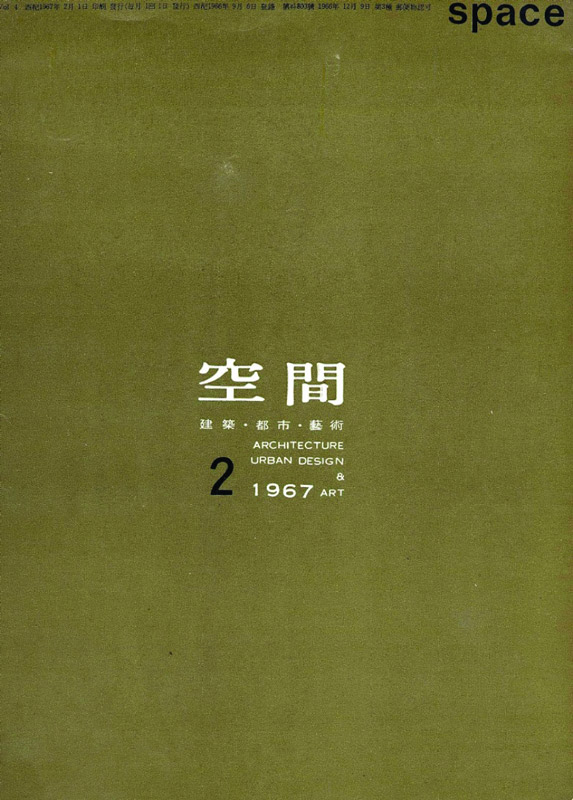
「SPACE」 Issue.4 (February, 1967)
It is well known that the debate on tradition prompted discussion of the nature of modern architecture in Korea, and since this point it has had a great influence on architectural discourse. This situation has clearly been reflected in SPACE since its establishment in November 1966. Tracing the trajectory of this discussion is very important in that not only it demonstrates in vivid terms the underlying nature of modern architecture in Korea, but also it reveals where the concept of Kim Swoo Geun and Space Group of Korea, the publisher of SPACE, were able to reach. Although these two pictures are generally overlapped, it seems that the concept of Kim Swoo Geun and SPACE Group of Korea seems to have been a catalyst for the development of modern architecture in Korea. Sparked by National Unified Museum of Korea (presently National Folk Museum of Korea) and Buyeo Museum (presently Buyeo National Museum) in 1966 and 1967 respectively, the debate on tradition predominated over more than a decade, and it expanded in the late 1980s with contemplation of the word ‘Koreanness’. However, meanwhile, Kim Swoo Geun presented his concept of ‘Ultimate Space’ in the Recipient Lecture of the Twelfth Pan Pacific Architectural Citation in 1971, conceiving of the École de Corée in the discussion of Korean Institute of Architects in 1978, and advocated for ‘Negativism’ of architecture in the 1980 UIA Region IV conference in Tokyo. This is one aspect of Korean modern architecture that has directly evolved from the debate on tradition. ‘Detailed Conditions Article 5-1. The building’s appearance, imitating some cultural properties, should express composition and texture vividly and it is allowed to imitate a couple of harmonious cultural properties [...] However, the interior should be planned as an ultra-modern facility with a touch of Korean style.’ The year 1966 marked a period of turbulence for the Korean architecture world due to concern surrounding design competition methods and the traditional style of the National Unified Museum of Korea. A series of events gave rise to many controversies, such as the Bureau of Cultural Property’s announcement of the design competition on the 8th of January, the selection of Kang Bong-jin’s proposal as the competition winner on the 10th of March, and the groundbreaking ceremony on the 22nd of November. SPACE held a roundtable later that year (moderator: Yoon Seung- joong, panels: Kim Chung-up, Kim Swoo Geun, Lee Gu) and offered harsh criticism of the imitation of traditional architecture in the museum design. This roundtable was published under the title of ‘How to Inherit Our Tradition in Architecture?’ in SPACE No. 3 (Jan. 1967) and the special feature in SPACE No. 4 (Feb. 1967) highlighted this issue. It was entitled ‘Special Feature: Symposium for Contemporary Architecture in Korea: Series Ⅰ – In the Case of the National Unified Museum of Korea’. This section included drawings of the winning proposal over several pages, a defensive statement on the winning proposal by Chung Inkuk (one of the jury members), documentation of the process from the competition announcement to the groundbreaking ceremony and the accompanying controversies, as well as numerous professionals’ opinions on the issue and a roundtable. Of course, what underlay all through the pages was harsh criticism of the winning proposal, which directly imitated exterior forms of some traditional buildings such as Palsangjeon Pavilion in Beopjusa Temple, ignoring various contemporary conditions. It seems that the alternative was provided by Lee Kyungsung’s critical writing, ‘Tradition and Creation’. Although appearing commonplace now, he argues that the best way to inherit tradition is to ‘re-create’ the ‘spirit’ from the ‘global perspective’ through ‘modern eyes’. We can also read something of the contemporary architects’ helplessness at that time in this special feature. When asked if they had ever built a building comparable to that of Palsangjeon Pavilion or Yeongnamru Pavilion by the Director of Bureau of Cultural Property, they had no choice but to remain silent. It was a helplessness at the apparent ‘distrust in modern architecture’, the title of the roundtable. Arguably, however, the raison d’être of SPACE was to battle against the distrust in modern architecture. Developing the discourse on the traditional-modern issue, it is no wonder SPACE was more on the ‘modern’ side. The title of the special feature also emphasised ‘modern’. This was perhaps because practising architects were leading SPACE. Not irrelevantly, Alain Delissen has ever argued that SPACE dealt with history in a different way from that of academia.▼1 In October of that year, SPACE No. 12 (Oct. 1967) highlighted the dispute over the Japanese style of the Buyeo Museum in the second series of this special feature: ‘Symposium for Contemporary Architecture in Korea: Series Ⅱ – Architectural Heritage and Proper Criticism’. Triggered by a report in Dong-A Ilbo on the 19th of August, 1967, the scandal lighted up newspapers and the architecture world, lasting for about a month. Compared to the controversy related to the National Unified Museum of Korea, which lasted for a year, this was drawn to a conclusion much faster. It seems not necessary here to go over this well-known debate again. Nevertheless, it is important to note that Korean architects’ attitude towards the succession of tradition has advanced in a degree. The controversy over the Japanese style of the Buyeo Museum is not about the direct imitation of tradition, but rather about the modern reinterpretation of tradition.▼2 The difference in interpretation garnered sharp criticism, even from colleagues (believed to be) in the same camp during the debate over the National Unified Museum of Korea. This Japanese-style controversy served as an opportunity for SPACE to re-examine the earlier issue of the creation of contemporary architecture and to re-emphasise the ‘justice of criticism’ by confirming the ‘absence of criticism’. Kim Won considered this controversy as rather fortunate in ‘Methods on Architectural Criticism’, the last article in the special feature, because the low-quality discussions so far could now be raised to the ‘level of criticism’. He thought of criticism as engagement, the responsibility of intellectuals, and argued that critics, together with architects, can contribute to the creation of contemporary architecture.▼3
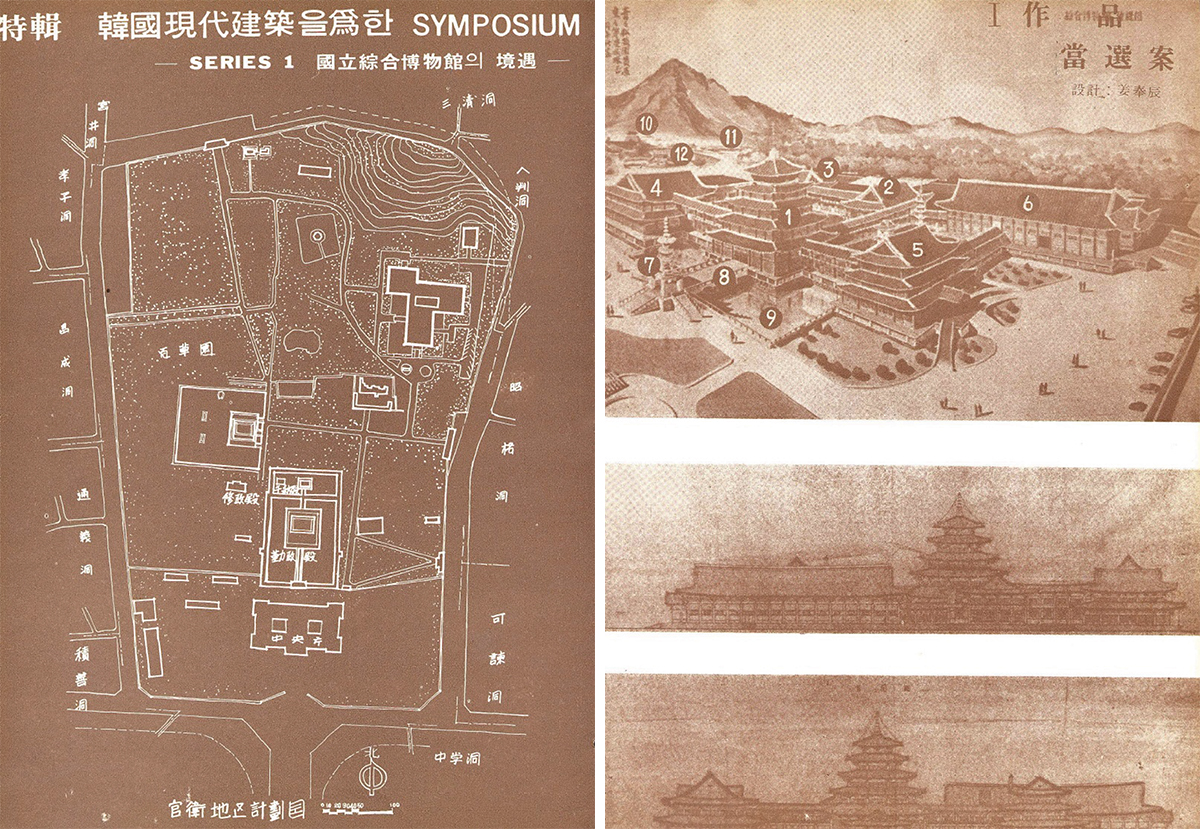
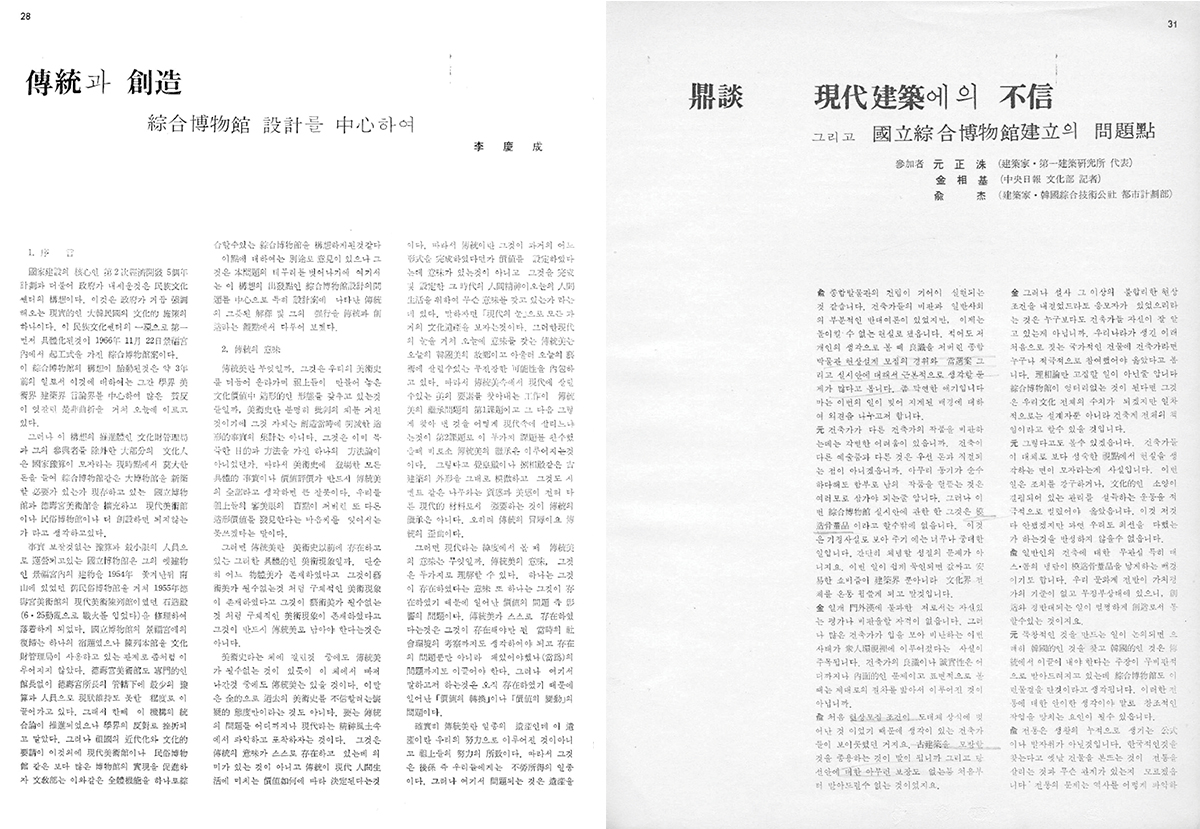
(top) ‘Special Feature: Symposium for Contemporary Architecture in Korea: Series Ⅰ ‒ In the case of the National Unified Museum of Korea’, SPACE No. 4, pp. 6 ‒ 7.
(bottom) The first page of Lee Kyungsung’s critic: ‘Tradition and Creation’ in Special Feature section of SPACE No. 4 (p. 28) and the first page of interviews with Won Jeong-Soo, Kim Sangki, and Yoo Kerl: ‘Distrust in contemporary architecture’ covered in SPACE No. 4 (p. 31).
The debate on tradition reported by SPACE in 1967 provided the basis to discuss the succession of tradition, which was repeated later. Awareness of how contemporary architecture would embrace tradition has gradually expanded through new special features,▼4 critiques collected in commemoration of the 100th issue of SPACE,▼5 or as part of an open forum in the SPACE GRAND PRIZE for Architecture;▼6 although there was still a large gap between theory and practice, and regression under the military government remains largely unchanged. While Lee Hitai’s National Theater (1966 ‒ 1973) and the Sejong Cultural Center (presently Sejong Center for the Performing Arts, 1973 ‒ 1977) were representative works of 1970s public architecture explored as subjects of critical discussion by SPACE, Kim Kiwoong’s Jeonju City Hall (1981 ‒ 1983) and the Independence Hall (1983 ‒ 1987) in the 1980s demonstrated how traditional elements could be adopted in public buildings much more freely, even implying postmodernism. However, in the meantime, we need to understand that discussions about the succession of tradition expanded to discussions of ‘Koreanness’. Even in the 1960s, the term ‘something Korean’ or ‘Korean thing’ existed, and in fact, it already contained the kernel of the meaning of ‘Koreanness’.▼7 However, SPACE didn’t pick up this term in earnest until it published a series of three special features, ‘The Rediscovery of Koreanness’ in 1987 after Kim Swoo Geun died. In the opening article of this series, ‘A Philosophical Consideration in Search of Koreanness’ in SPACE No. 238 (June 1987), So Heungryul categorised the ‘Koreanness’ of architecture into the ‘traditional’, ‘artistic’, and ‘ideological’. He argued that Koreanness should outdo the traditionalist position so as to contain the universal value of art and eventually express the ideology of the times. This ‘ideological Koreanness’ seemed to be a systematised version of the claims raised in the 1960s, such as Lee kyungsung’s emphasis on the need to re-create the spirit of tradition in a modern way. As the concept behind the discussion widened from ‘traditionality’ to ‘Koreanness’, the scope of the architects’ creation was also expanded.The question was how to interpret the Korean ‘spirit’ or ‘ideology’.
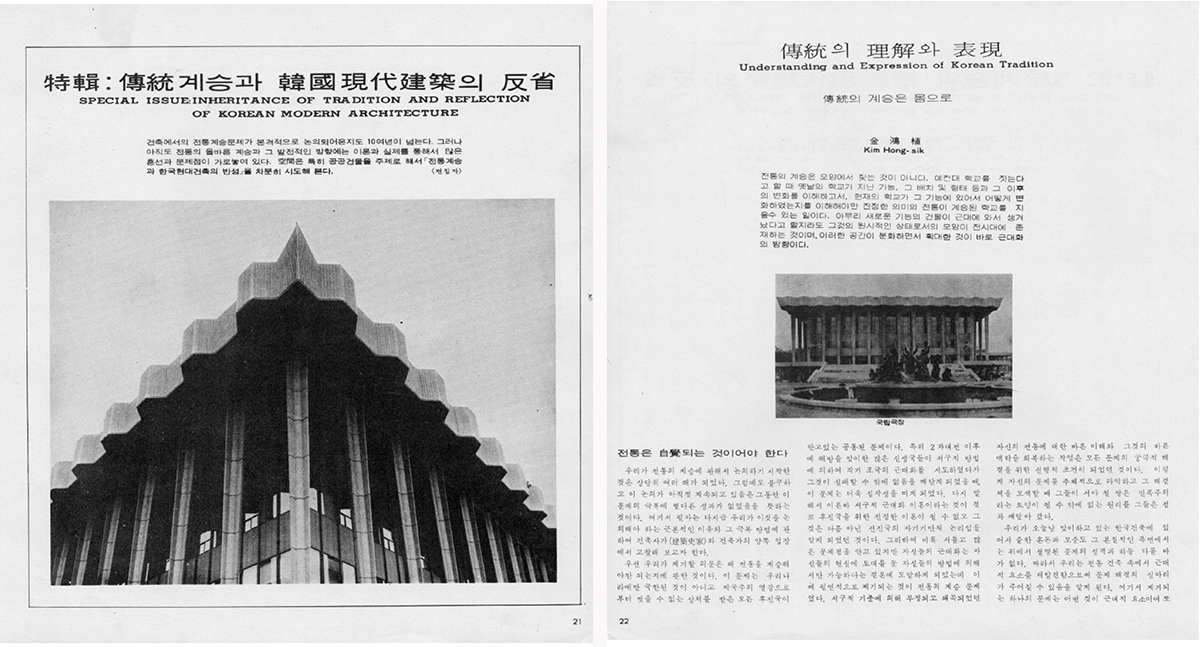
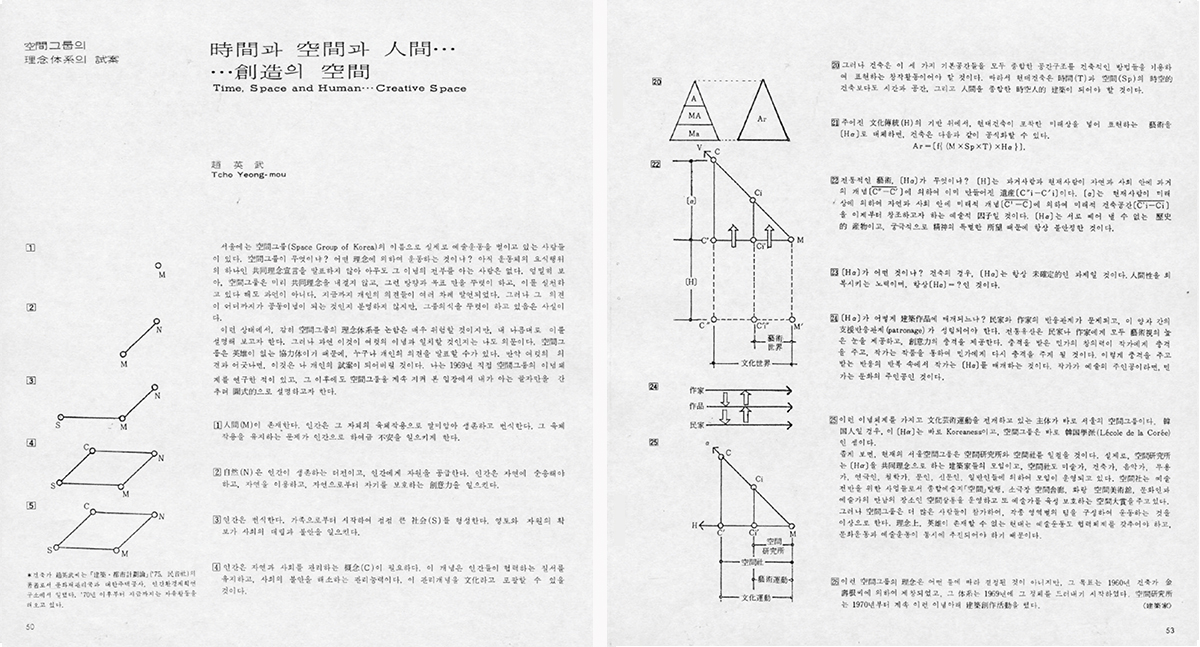
(top) ‘Special Issue: Inheritance of Traditional and Reflection of Korean Modern Architecture’, SPACE No. 131 (May 1978), pp. 21 ‒ 22.
(bottom) Tcho Yeongmou, ‘Time, Space and Human… Creative Space’, SPACE No. 150/151 (Dec. 1979, Jan. 1980 double issue), pp. 50, 53.
Discussion of tradition and ‘Koreanness’, which lasted and expanded in the 1960s ‒ 1980s, may be recognised as outlining the coordinates of a general solution for the entire Korean architecture world. SPACE mediated and led the trend, but the architectural direction of Kim Swoo Geun’s SPACE Group of Korea inevitably took on the character of a special solution because it was a private design organisation. In this picture, it may be said that the special solution was created based on the general solution but the special one outpaces the general. Kim Swoo Geun’s ‘Ultimate Space’ presented in 1971 had the premise that ‘The essence of our environment should be understood from an internal and spiritual point of view, not from a physical one’ (SPACE No. 56 [July 1971]). He paid attention to the munbang (Korean traditional studyroom as multi-use cultural space for elite nobleman) and the jengja (Korean pavilion) in the traditional Korean house, not because of their appearance but because of their space, which offers the spirituality of ‘contemplation’, ‘placidity’ and ‘pure play’. This seems to be the value of tradition, the value in which he chose to immerse himself following the bitter experience of the controversy concerning the Japanese style of his Buyeo Museum. ‘Negativism’ is the very concept that encompasses this ‘Ultimate Space’, originating from traditional philosophies of Confucianism, Buddhism, and Taoism (SPACE No. 162 [Dec. 1980]). In retrospect, Kim Swoo Geun’s special solution must have the charm to draw a general solution. However, it seems that École de Corée, which he proposed as part of the discussion of Korean Institute of Architects in 1978, failed to gain a place in the coordinates of the general solution because it became too specialised in subsequent discussions.▼8 If reconstructing his arguments, École de Corée deserves to be defined as ‘a group that contributes to mankind by creating architectural culture laced with a Korean môt (Hα)’. Although open to interpretation, his concept of the Korean môt or ‘Korean flavour’ was very encouraging. However, in his 1978 discussion, there was concern that his functional relationship ‘A=f(H+S)t+Hα’ includes mathematical determinism.▼9 Tcho Yeongmou seems to have exposed such concerns in his excessive diagraming when he was theorising an ideological system for the SPACE Group of Korea.▼10 On the other hand, his ambitious project to maintain École de Corée seems to have failed to meet a sense of global universality as he took a turn towards nationalism based on some ambiguous pre- historic teachings. In a lecture, ‘From the Search for Cultural Archetypes to the Proposal of École de Corée’ for KONGKAN Forum, held several years after Kim Swoo Geun’s death, he exposed the theoretical limitations through a double myth – he mythicised Kim Swoo Geun and the SPACE Group of Korea as the modern successor of the myth of ancient ‘Hwandan Architecture’ (SPACE No. 266 [Oct. 1989]). In a sense, it was Seung H-Sang’s lecture ‘On Architect Kim Swoo Geun’ at the same forum in the following year that showed a modest reality in explaining ‘Hα-space’ (SPACE No. 272 [Apr. 1990]), even though the lecture also played a part in establishing the Kim Swoo Geun myth. From the debate on tradition in the 1960s to the proposal of École de Corée in the 1980s, the discourse cultivated by SPACE was consistently directed towards the creation of Korean contemporary architecture. So, what kind of Koreanness should be represented in the Korean architecture of the new century? Or, do we still need this notion of Koreanness? Let’s discuss this issue next time. (written by Hyon-Sob Kim / edited by Bang Yukyung)
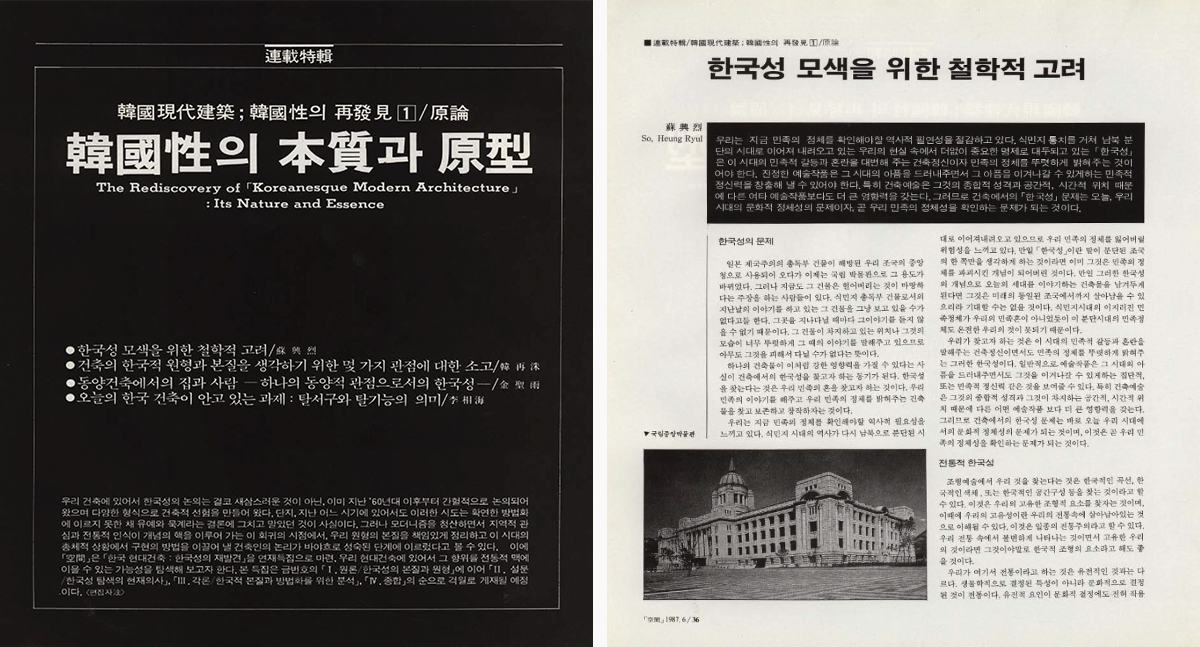
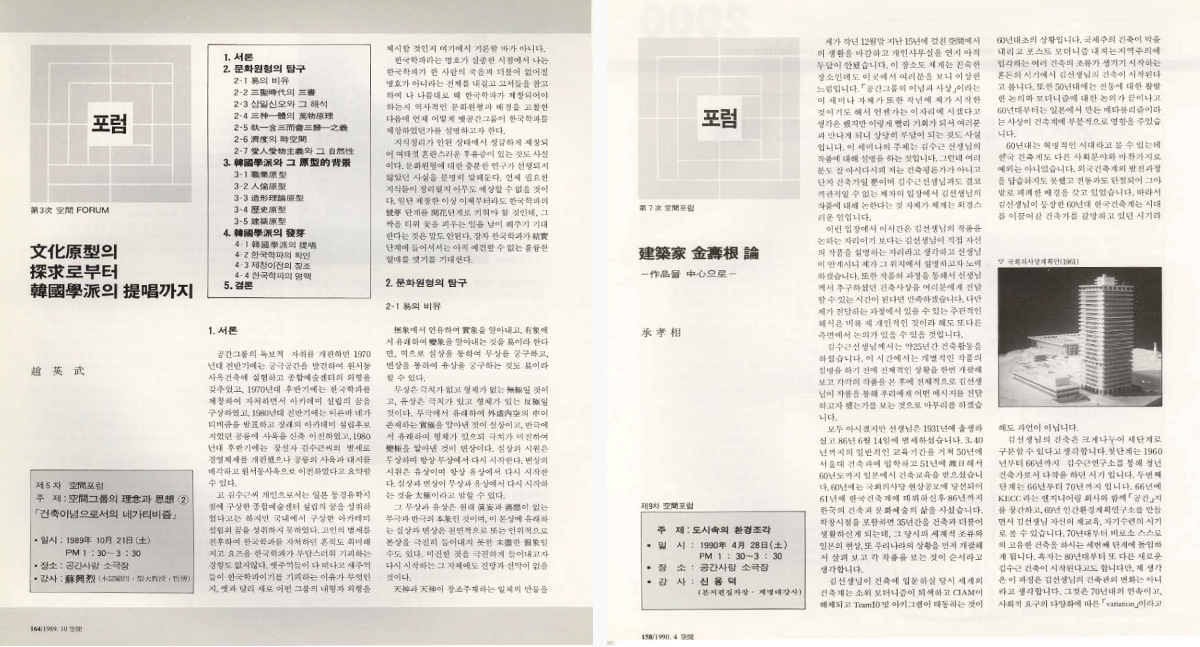
(top left) ‘Special Feature: The Rediscovery of Koreanness Modern Architecture: Its Nature and Essence’, SPACE No. 238 (June 1987), p. 35.
(top right) So Heungryul, ‘Philosophical Consideration in Search of Koreanness’, SPACE No. 238, p. 36.
(bottom left) Tcho Yeongmou, ‘From the Search for Cultural Archetypes to the Proposal of École de Corée’, SPACE No. 266 (Oct. 1989), p. 164
(bottom right) Seung H-Sang, ‘On Architect Kim Swoo Geun’, SPACE No. 272 (Apr. 1990), p. 158.
In our next issue, Park Junghyun will cover ‘A Critical Estimation on Post-modern Architecture’, which featured in SPACE No. 261 (May 1989).
-
1 Alain Delissen argues that SPACE in the 1960s ‒ 1980s played a role in connecting ‘formal history’ with ‘public culture’ unlike ‘academic historiography’. In other words, he claims that SPACE sought national identity by popularising and aestheticising the past. Although some historians contributed to the magazine, they were only in the minority of the opinions expressed. In addition, many images of the past published in SPACE were not dated, and references for the text were not necessarily specified. However, Delissen notes that SPACE operated as a ‘mnemonic site’ in its own way. Alain Delissen, ‘The Aesthetic Pasts of Space (1960 ‒ 1990)’, Korean Studies 25.2 (2002), pp. 243 ‒ 260.
2 Construction of this building began in 1965, and it was partially completed when embroiled in the controversy over the Japanese style.
3 In fact, Lee Gu had already emphasised the necessity of criticism proper at the roundtable for SPACE No. 3 (Jan. 1967). However, SPACE (or the Korean architecture world) did not deal with architectural criticism more actively until more than a decade passed. Refer to the special feature ‘Architectural Criticism’ of SPACE No. 205 (July 1984), and the special feature ‘RE-VISIT SPACE 6’ of SPACE No. 643 (June 2021).
4 ‘Succession of Tradition in Architecture’, SPACE No. 96 (May 1975), pp. 3 ‒ 26; ‘Special Issue: Inheritance of Traditional and Reflection of Korean Modern Architecture’, SPACE No. 131 (May 1978), pp. 21 ‒ 37.
5 Park Youngho, ‘A Study of Traditionalism in Korean Architecture Expressions of Traditions’, SPACE No. 100 (Sep. 1975), pp. 117 ‒ 123.
6 So Heungryul and Won Jeong-Soo and Yoon Seungjoong and Kim Swoo Geun, ‘Open forum for the 3rd SPACE GRAND PRIZE for Architecture—A Meeting Place of Tradition and Modernity’, SPACE No. 138 (Dec. 1978), pp. 9 ‒ 11.
7 ‘When discussing making something original, we tend to look for something Korean and accept in uncritical mode that it is necessary to draw something Korean from tradition [...] The very naïve thinking about tradition is the factor that can ruin creative work. Or it can be.’ Won Jeong-Soo’s statement in the interview for special feature, ‘Distrust in contemporary architecture’, SPACE No. 4 (Feb. 1967), p. 31.
8 Tcho Yeongmou highlights Kim Swoo Geun’s keynote paper, ‘Cultural Mediation in Architecture’ with the sketch of the entire discussion. Tcho Yeongmou, ‘The discussion of Korean Institute of Architects in 1978: Architects as a Professional’, SPACE No. 139 (Jan. 1979), pp. 109 ‒ 116. The Korean Institute of Architects pre-published four keynote papers including Kim Swoo Geun’s in the November 1978 issue of Architects, and the full text of the discussion was published in the following issue in January 1979.
9 ‘A’ stands for architecture, ‘f(H+S)’ for function of human and space, ‘t’ for time, and ‘Hα (Heritage α)’ for Korean môt. This formula was slightly adjusted to ‘A=f(S×T×M)+Hα’ at the discussion. ‘f(S×T×M)’ means, of course, a function of space, time, and man.
10 Tcho Yeongmou, ‘Time, Space and Human… Creative Space’, SPACE No. 150/151 (Dec. 1979, Jan. 1980 double issue), pp. 50 ‒ 53.




